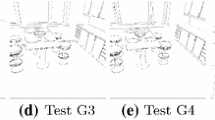Abstract
GPU based ray casting has become a valuable tool for the visualization of medical image data. While the method produces high-quality images, its main drawback is the high computational load. We present a novel adaptive approach to speed up the rendering. In contrast to well established heuristic methods, we use the spectral decomposition of the transfer function and the dataset to derive a suitable sampling criterion. It is shown how this criterion can be efficiently incorporated into an adaptive ray casting algorithm. Two medical datasets, which each represent a typical, but different material distribution, are rendered using the proposed method. An analysis of the number of sample points per ray reveals that the new algorithm requires 50% to 80% less points compared to a non-adaptive method without any quality loss. We also show that the rendering speed of the GPU implementation is greatly increased with reference to the non-adaptive algorithm.
Access this chapter
Tax calculation will be finalised at checkout
Purchases are for personal use only
Preview
Unable to display preview. Download preview PDF.
Similar content being viewed by others
References
Bergner, S., Moller, T., Weiskopf, D., Muraki, D.J.: A spectral analysis of function composition and its implications for sampling in direct volume visualization. IEEE Transactions on Visualization and Computer Graphics 12(5), 1353–1360 (2006)
Crassin, C., Neyret, F., Lefebvre, S., Eisemann, E.: Gigavoxels: Ray-guided streaming for efficient and detailed voxel rendering. In: Proceedings of the 2009 Symposium on Interactive 3D Graphics and Games, pp. 15–22. ACM, New York (2009)
Engel, K., Kraus, M., Ertl, T.: High-quality pre-integrated volume rendering using hardware-accelerated pixel shading. In: Proceedings of the ACM SIGGRAPH/EUROGRAPHICS Workshop on Graphics Hardware, p. 16. ACM, New York (2001)
Gobbetti, E., Marton, F., Iglesias Guitián, J.A.: A single-pass GPU ray casting framework for interactive out-of-core rendering of massive volumetric datasets. The Visual Computer 24(7), 797–806 (2008)
Kraus, M.: Direct volume visualization of geometrically unpleasant meshes (2003)
Kraus, M., Strengert, M., Klein, T., Ertl, T.: Adaptive sampling in three dimensions for volume rendering on GPUs. In: 2007 6th International Asia-Pacific Symposium on Visualization, APVIS 2007, pp. 113–120 (2007)
Kruger, J., Westermann, R.: Acceleration techniques for GPU-based volume rendering. In: IEEE Visualization, VIS 2003, pp. 287–292 (2003)
Ljung, P.: Adaptive sampling in single pass, GPU-based raycasting of multiresolution volumes. In: Proceedings Eurographics/IEEE Workshop on Volume Graphics 2006, pp. 39–46 (2006)
Marschner, S.R., Lobb, R.J.: An evaluation of reconstruction filters for volume rendering. In: Proceedings of the Conference on Visualization 1994, pp. 100–107. IEEE Computer Society Press, Los Alamitos (1994)
Roettger, S., Guthe, S., Weiskopf, D., Ertl, T., Strasser, W.: Smart hardware-accelerated volume rendering. In: Proceedings of the Symposium on Data Visualisation 2003, Eurographics Association, p. 238 (2003)
Rubin, G.D., Beaulieu, C.F., Argiro, V., Ringl, H., Norbash, A.M., Feller, J.F., Dake, M.D., Jeffrey, R.B., Napel, S.: Perspective volume rendering of CT and MR images: applications for endoscopic imaging. Radiology 199(2), 321 (1996)
Schulze, J.P., Kraus, M., Lang, U., Ertl, T.: Integrating pre-integration into the shear-warp algorithm. In: Proceedings of the 2003 Eurographics/IEEE TVCG Workshop on Volume Graphics, p. 118. ACM, New York (2003)
Author information
Authors and Affiliations
Editor information
Editors and Affiliations
Rights and permissions
Copyright information
© 2010 Springer-Verlag Berlin Heidelberg
About this paper
Cite this paper
Suwelack, S., Heitz, E., Unterhinninghofen, R., Dillmann, R. (2010). Adaptive GPU Ray Casting Based on Spectral Analysis. In: Liao, H., Edwards, P.J."., Pan, X., Fan, Y., Yang, GZ. (eds) Medical Imaging and Augmented Reality. MIAR 2010. Lecture Notes in Computer Science, vol 6326. Springer, Berlin, Heidelberg. https://doi.org/10.1007/978-3-642-15699-1_18
Download citation
DOI: https://doi.org/10.1007/978-3-642-15699-1_18
Publisher Name: Springer, Berlin, Heidelberg
Print ISBN: 978-3-642-15698-4
Online ISBN: 978-3-642-15699-1
eBook Packages: Computer ScienceComputer Science (R0)




